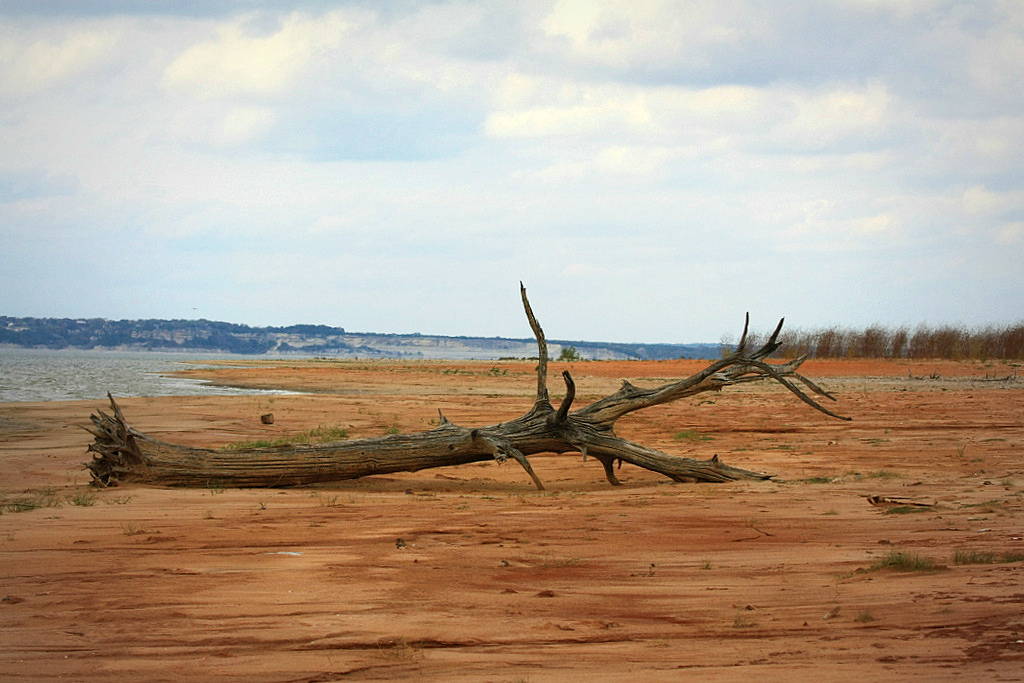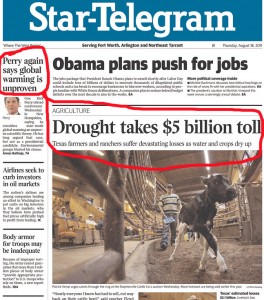
This post first ran on January 26, 2012. Since then, we’ve continued to set records for the hottest year on record.
My question began with a social media status update by my friend Paolo Bacigalupi. Paolo wrote:
At what point does a “drought” become an “arid climate?”
Paolo posed his question months ago, and at first glance, it seemed like nothing more than a jab at Texan politicians like Rick Perry, who deny climate change even as evidence for it accumulates in their own backyards.
But my mind has circled back to Paolo’s question because it touches on so much more than just rainfall in the Southwest. It’s also about the scientific process, the line between data and interpretation and the role of story in science.
We like to think of science as a dispassionate entity. It’s truth, with a capital T. But the reality is that science is also infused with human values and judgements.
The amount of rain that has fallen (or not) in Texas is a datum, a discrete, measurable, knowable fact. But the human mind does not think in numbers, it thinks in story. The terms drought and arid climate are interpretive labels that scientists attach to data — they’re the stories they tell to make sense of precipitation figures.
Scientists have spent years developing climate models to help them make predictions about the future climate in the Southwestern U.S. These predictions become narratives for explaining the numbers.
I posed Paolo’s question to Richard Seager, a climate scientist at the Lamont Doherty Earth Observatory of Columbia University. “A drought is a time when it’s drier than normal,” he told me. “If a drought is not going to end, then it represents a transition to a drier climate.”
As Seager wrote in a 2007 Science paper about the Southwest,
…there is a broad consensus among climate models that this region will dry in the 21st century and that the transition to a more arid climate should already be under way. If these models are correct, the levels of aridity of the recent multiyear drought or the Dust Bowl and the 1950s droughts will become the new climatology of the American Southwest within a time frame of years to decades.
The problem is that the predicted transition has an amplitude that’s modest compared to the expected year to year or decade to decade variability. “At this point in time, trying to find some emerging trend that is relatively small compared to the natural variability—that’ s a really tricky, almost impossible problem to solve,” Seager says.
Seager calls the severity of the drought going on in Texas right now “quite remarkable,” but says it has also been fairly short. While Texas and the Southwest have experienced drought off and on over the last decade or so, this most recent Texas drought didn’t begin until the fall of 2010, and it seems related to a La Nina event.
Researchers are trying to determine if the “incredibly hot” temperatures hitting the region are linked to human activity, but there aren’t any final conclusions yet, Seager says. It’s possible that the current drought is the result of natural variability, but even so, Seager says, “It’s the kind of event that will become more likely in the region as the amplitude of the anthropogenically induced drying of the region gets stronger and stronger.”
He points to an analogy proposed by climatologist Heidi Cullen. She likens climate change to steroids in baseball. You can’t take any one home run that Barry Bonds hit and say, “a-ha, this one was caused by steroids!” But look at the steroid seasons together and compare them to historic home run data and you can see that the home runs are outside the natural pattern.

In this analogy, a drought is like a single home run. It’s only by looking at it in context that you can determine where it fits with previous patterns. Which means that we won’t be able to definitively say that what we’re seeing in Texas is a more arid climate until we’re fully entrenched in this new normal.
Even then, it remains open to interpretation. While the rainfall data themselves are indisputable facts, the criteria that scientists use to define concepts like drought, climate and normal are human constructs. Even when they’re based on science, they’re still judgment calls.
It’s the existential layer to Paolo’s question that intrigues me most. How much contrary evidence do we need before we decide it’s time to update our definition of normal? At what point do we as humans let go of the past — the way things were, the present that we’re used to — and accept the future that we’ve created? When do we quit denying the consequences of our actions and start incorporating them into our collective narrative?
These aren’t scientific questions, they’re philosophical ones, and until society can agree on the answers, debate about climate change will continue.
***
Photos:
Drought on the shores of Lake Whitney by TexasEagle (via Flickr)
Dueling headlines by My Eyes See (via Flickr)